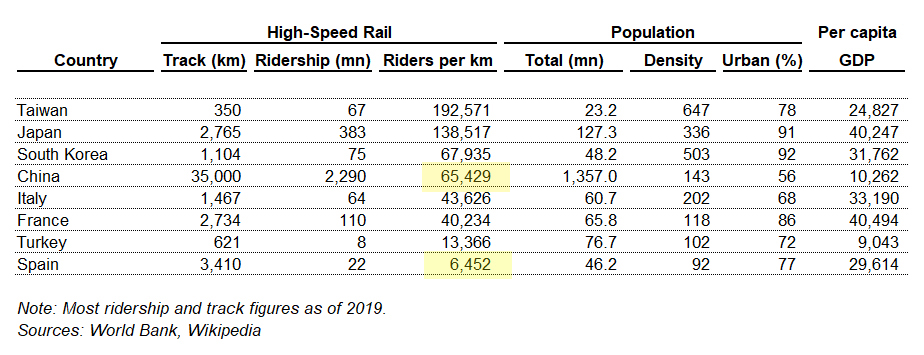This analysis neglects the most important variable in evaluating high fixed cost infrastructure projects like HSR: utilization.
Spain’s 3,000 km HSR network was used by 22 million passengers last year.
China’s 35,000 km network was used by 2.3 billion. That’s a 10x difference. https://twitter.com/michaelxpettis/status/1297126085532975104">https://twitter.com/michaelxp...
Spain’s 3,000 km HSR network was used by 22 million passengers last year.
China’s 35,000 km network was used by 2.3 billion. That’s a 10x difference. https://twitter.com/michaelxpettis/status/1297126085532975104">https://twitter.com/michaelxp...
Moreover, ridership is increasing single-digits in Spain and still increasing 15%+ in China.
(Pre-COVID numbers of course)
So just because it’s not working out for Spain doesn’t mean it doesn’t make economic sense in China.
(Pre-COVID numbers of course)
So just because it’s not working out for Spain doesn’t mean it doesn’t make economic sense in China.
Utilization is reflected in ticket prices:
The 500km trip between Madrid and Barcelona costs $187 in economy class.
Trip from Wuhan and Nanjing (over 500 km) costs $22 in 2nd class.
The 500km trip between Madrid and Barcelona costs $187 in economy class.
Trip from Wuhan and Nanjing (over 500 km) costs $22 in 2nd class.
Utilization also reflects itself in convenience:
The Madrid-Barcelona lines runs 1 train every two hours.
The Wuhan-Nanjing line runs 2-4 every hour.
Because of this, except for peak travel periods, HSR tickets in China are typically purchased on an ad hoc basis.
The Madrid-Barcelona lines runs 1 train every two hours.
The Wuhan-Nanjing line runs 2-4 every hour.
Because of this, except for peak travel periods, HSR tickets in China are typically purchased on an ad hoc basis.
This table shows very clearly why Spain& #39;s HSR network is having a difficult time generating a proper economic return compared to other HSR systems
Spain& #39;s network is 24% longer than Japan& #39;s famed Shinkansen, but attracts less than 6% the annual ridership.
For every km of track in operation, ~18 people use it every day. In Japan, the equivalent number is over 500.
For every km of track in operation, ~18 people use it every day. In Japan, the equivalent number is over 500.
For China this number is 179. China is about half as efficient when it comes to this metric as Japan, but it is also still in high growth mode.
And it is getting more efficient over time. Even as track length has tripled since 2011, ridership has quintupled.
And it is getting more efficient over time. Even as track length has tripled since 2011, ridership has quintupled.

 Read on Twitter
Read on Twitter


